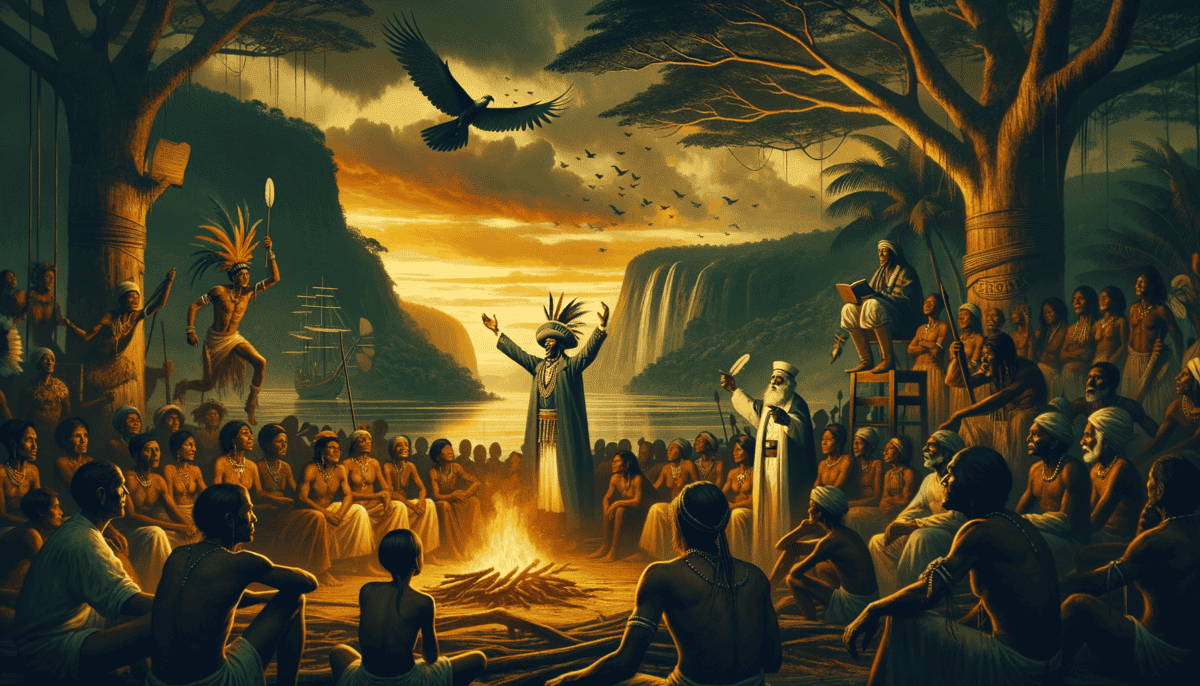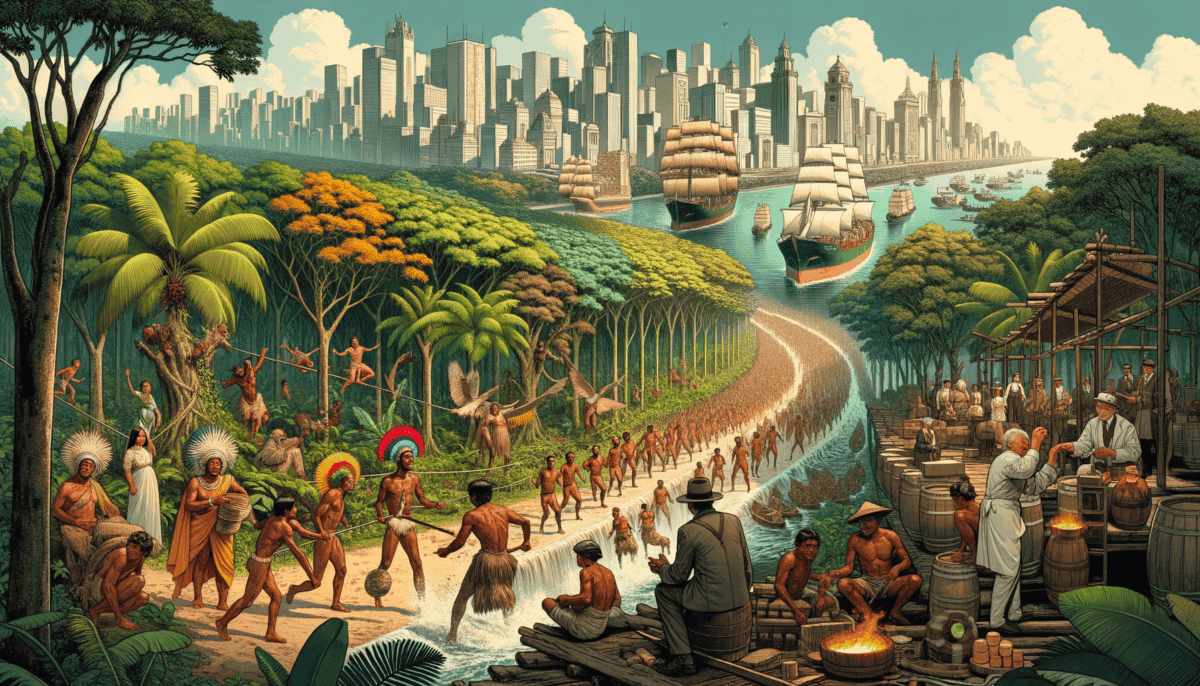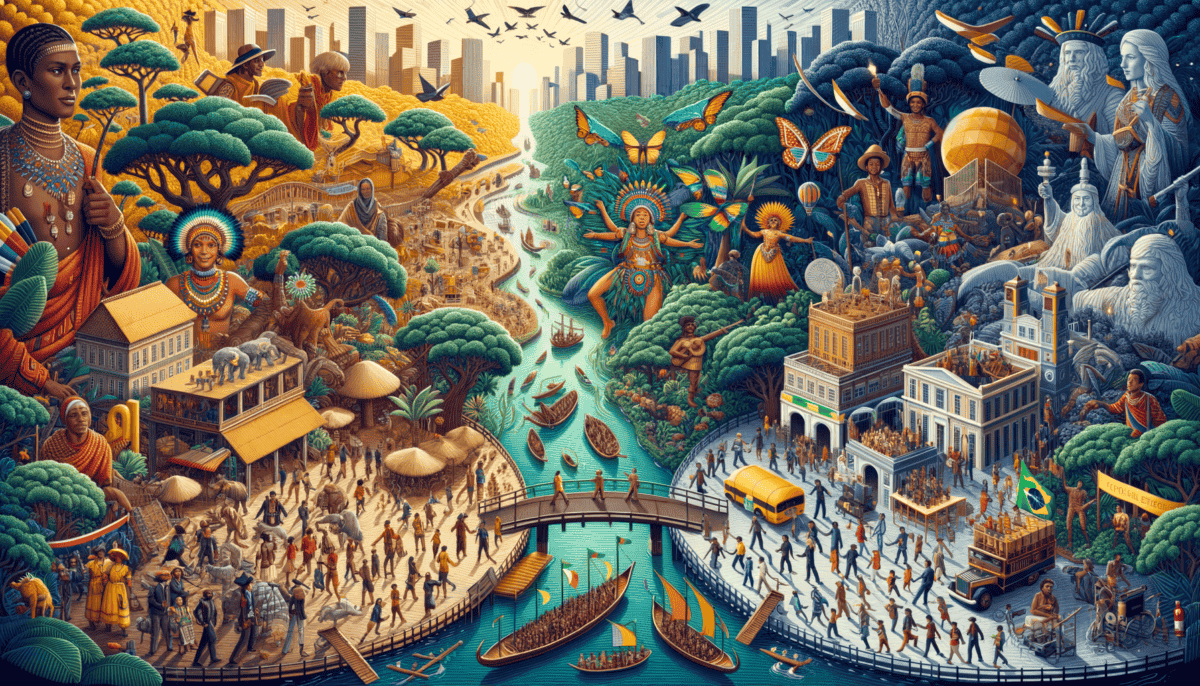Land of the First Peoples
Deep in the heart of South America, where the Amazon River flows like a giant snake through the rainforest, lived many groups of people long before anyone else came to Brazil.
The sun peeked through tall trees as Tainá, a young girl from the Tupí tribe, walked with her grandfather along a narrow path. The air was warm and sticky, filled with the songs of colorful birds and playful monkeys.
"Grandfather," Tainá asked, "why do we call this place home?"
Her grandfather smiled, his eyes twinkling like stars. "Our people have lived here since the time of the first sunrise. We know every tree, every plant, and every animal that shares this forest with us."
The Tupí weren't alone in this vast land. Many different tribes lived across Brazil:
• Amazon River tribes who built canoes and fished
• Coastal peoples who gathered shells and built villages
• Forest dwellers who hunted and gathered fruits
• Mountain tribes who made beautiful pottery
Tainá watched as women from her village wove bright baskets from palm leaves. Others painted their bodies with natural dyes made from berries and plants. The designs told stories of their tribe's history.
"We don't just live in the forest," her grandfather explained. "We are part of it. Every tree, every river has a spirit."
At night, the village gathered around a big fire. The tribe's storyteller shared tales about brave hunters, clever animals, and how the stars came to be in the sky. Everyone listened carefully – these stories were their way of keeping their history alive.
The first peoples of Brazil didn't need written words. They passed down their knowledge through songs, dances, and stories.
In their villages, children played games with wooden toys and learned important skills from their elders. Boys learned to hunt with bows and arrows, while girls learned which fruits were safe to eat and how to make medicine from plants.
"Look," Grandfather pointed to a toucan flying overhead. "Even the birds know this is a special place."
Life wasn't always easy in the rainforest. During heavy rains, the rivers would rise, and during dry seasons, some plants would become scarce. But the first peoples knew how to adapt and take care of their home.
“We take only what we need,” Grandfather told Tainá. “That way, there will always be enough for everyone, including the animals and plants.”
These first peoples lived this way for thousands of years. They built great communities without cutting down the forest. They knew how to fish without emptying the rivers. They were the true guardians of Brazil.
As the day ended, Tainá sat with her family, eating fresh fruits and fish. The sounds of the forest created a peaceful melody – frogs croaking, crickets chirping, and the gentle rustle of leaves in the wind.
This was Brazil before big changes came – a land where people lived in harmony with nature, where every day brought new adventures, and where wisdom was passed down from one generation to the next. Little did they know that their peaceful world would soon meet new people from across the great ocean.
When Ships Touched Shore
The morning sun sparkled on the ocean waves as strange ships appeared on the horizon. It was April 22, 1500, and Brazil was about to change forever.
Pedro Álvares Cabral stood tall on his ship’s deck. He had sailed all the way from Portugal with thirteen big boats. The sailors were tired but excited to see land after months at sea.
“Look!” shouted a young sailor named João. “There are people on the beach!” The indigenous Tupí people had gathered to watch these strange floating houses approach their shore.
At first, both groups were curious about each other. The Portuguese had never seen people paint their bodies or wear such colorful feathers. The Tupí had never seen people with metal armor or big ships.
“These visitors wear funny clothes,” whispered a Tupí child to his mother. “Why do they cover themselves in metal?”
The Portuguese brought gifts: mirrors, bells, and cloth. The Tupí shared their fruits and showed the visitors how to find fresh water. For a short while, things seemed peaceful.
But soon, more Portuguese ships came. They weren’t just visitors anymore – they wanted to stay. They started building houses and cutting down trees to make room for farms.
The Portuguese discovered something valuable in Brazil – a tree with red wood that could make beautiful red dye. They called it “pau-brasil,” which is how Brazil got its name.
Life changed quickly. The Portuguese brought:
• New foods like sugarcane
• Different animals like cows and chickens
• Their language (Portuguese)
• Their religion
• New diseases that made many indigenous people sick
The Portuguese made big farms called plantations. They needed many workers, so they started bringing people from Africa as slaves. This was very wrong and hurt many people.
Many indigenous peoples had to leave their homes in the forest. Some fought back to protect their land. Others moved deeper into the forest to stay away from the newcomers.
João, the young Portuguese sailor, became friends with a Tupí boy named Apoena. One day, Apoena asked, “Why do your people want to change everything?”
João didn’t have an answer. He was starting to see that the beautiful land he had found was already someone’s home.
Some brave Portuguese learned from the indigenous peoples. They discovered new fruits, learned which plants could heal sick people, and found better ways to survive in the hot weather.
As years passed, Brazil became different from both Portugal and the indigenous lands it used to be. It became a new place where people from Europe, Africa, and the original inhabitants of the land lived together – though not always fairly or peacefully.
The ships that arrived that morning in 1500 brought big changes to Brazil. Some changes were exciting, like new foods and tools. Other changes hurt people and destroyed parts of the beautiful forest. This was just the beginning of Brazil’s story of becoming the country we know today.
Freedom Fighters Rise
Deep in the Brazilian forests, a special place called Palmares grew strong. It was where brave people who escaped slavery made their own free home.
A young boy named Zumbi lived here with his family. He watched as more people came to Palmares every day. They built houses high in the hills where they could see if anyone was coming to hurt them.
Zumbi grew up to be a strong leader. He learned to read and write, which was rare in those days. He also learned how to protect his people.
“In Palmares, we are all free,” Zumbi would say. “Here, we can dance our dances and sing our songs without fear.”
Life in Palmares was different from the Portuguese towns. People shared everything they had:
• Food from their gardens
• Tools they made
• Stories from their homelands
• Songs and dances from Africa
The people of Palmares grew corn, beans, and sweet potatoes. They made their own tools and weapons. Some people who had been slaves taught others how to make things they learned in the Portuguese towns.
Every night, they lit fires and told stories about their dreams of freedom. The flames danced in their eyes as they remembered their homes in Africa.
But the Portuguese didn’t like Palmares. They were angry that slaves were running away. They sent soldiers to try to destroy the quilombo.
Little Maria, who lived in Palmares, asked her grandmother, “Why do they want to hurt us?”
“Because they don’t understand that all people should be free,” her grandmother answered softly.
Zumbi was very clever. He taught everyone how to fight and hide in the forest. When soldiers came, the people of Palmares would disappear into secret places in the trees.
Other slaves heard about Palmares. They told stories about the free city in the forest. More and more people tried to escape to find it.
In other parts of Brazil, more quilombos started to grow. Each one was like a little light of hope in the dark forest. They showed that people could live free and happy together.
The Portuguese tried many times to destroy Palmares. But for almost 100 years, it stayed strong. Zumbi led his people in protecting their home.
Even today, people remember Zumbi and Palmares. They teach us that fighting for what’s right is important, even when it’s hard.
In cities across Brazil, people started talking about freedom. They didn’t think it was right for some people to own others. More and more people joined together to fight against slavery.
Young children in Palmares learned important lessons. They learned that everyone deserves to be free. They learned that working together makes people strong. And they learned that sometimes you have to be brave to make things better.
The story of Palmares and Zumbi spread throughout Brazil. It gave hope to people who weren’t free and showed that things could change. The fight for freedom was just beginning, but brave people were ready to stand up for what was right.
A Nation Dreams of Freedom
The warm Brazilian sun rose over Rio de Janeiro. The year was 1821, and something big was about to happen. People filled the streets, talking about freedom from Portugal.
Young Pedro, the son of the Portuguese king, walked through the gardens of his palace. He could hear the voices of people calling for change.
A little girl named Ana watched from her window as people gathered in the square. “Mama, why are there so many people outside?” she asked.
“They want Brazil to be free, my dear,” her mother explained. “Like a bird flying from its cage.”
Pedro listened to the Brazilian people. They told him about their dreams:
• To make their own rules
• To trade with any country they wanted
• To speak with their own voice
• To be proud Brazilians
One day, Pedro got a letter from his father in Portugal. It said he must come home right away. But Pedro looked at the beautiful land around him and thought about all the Brazilian people who trusted him.
“If this is what the people want,” Pedro declared, “then I will stay! Brazil shall be free!”
This famous moment became known as the “Day of I Stay.” Pedro stood by the river called Ipiranga and shouted, “Independence or Death!” ️
Little João, who sold oranges in the street, heard the news and jumped with joy. “Does this mean we’re free?” he asked his father.
“Yes, son,” his father smiled. “We are becoming our own country now.”
Pedro became Emperor Pedro I of Brazil. He worked to make Brazil strong and free. He wrote new laws that gave people more rights.
In schools, children learned to be proud of their Brazilian heritage. They sang new songs about their country and drew the new Brazilian flag – green for forests, yellow for gold, and blue for the sky.
Maria, a teacher in Rio, gathered her students around a map. “Look at how big our country is,” she said. “From the Amazon River to the southern plains, it’s all Brazil now!” ️
People from different parts of Brazil started working together. They built new cities and opened schools. Farmers grew coffee and sugar cane. Ships carried Brazilian goods to countries far away.
But not everything was perfect. Many people still weren’t free. The fight against slavery would continue. And some people thought Brazil needed different leaders.
In the streets of Rio, Salvador, and São Paulo, people danced and celebrated their new country. They played music on drums and guitars, singing songs about Brazilian pride.
Young artists painted pictures of Brazil’s beautiful landscapes. Writers wrote poems about freedom. Everyone felt like they were part of something new and exciting.
Pedro’s son, who would become Pedro II, watched and learned. He knew he would need to help Brazil grow stronger and better. The story of Brazil was still being written.
As the sun set over Rio’s beautiful bay, people looked to the future with hope. Brazil was now its own country, ready to write its own story. The dream of freedom had become real, but there were still many adventures ahead. ⭐
Growth and Change in a New Nation
The sun sparkled on the Amazon River as boats loaded with rubber sailed downstream. It was 1880, and Brazil was changing fast!
“Look at all the ships!” young Maria exclaimed, pointing at the busy harbor in Manaus. Her father worked collecting rubber from trees in the rainforest.
In the city of São Paulo, factories were popping up like mushrooms after rain. People from Italy, Japan, and Germany came to work and live in Brazil. They brought new foods, music, and ideas.
“My grandmother makes the best sushi now,” giggled Pedro, a young boy whose Japanese family had just opened a restaurant. “But she loves Brazilian beans too!”
Cities grew bigger and taller. In Rio de Janeiro, workers built beautiful buildings with gold and marble. Trains started running between cities, carrying coffee beans and cotton.
Here are some of the big changes happening in Brazil:
• New factories making clothes and tools
• Farms growing more food than ever
• Cities getting electric lights
• Schools teaching more children
• Artists creating new kinds of music
In the countryside, Carlos watched his father plant coffee trees. “Will these trees make Brazil rich?” he asked.
“They already are, son,” his father smiled. “Our coffee goes to breakfast tables around the world!” ☕
In the streets of Salvador, Ana’s grandmother taught her to dance samba. “This is our music,” she said proudly. “It comes from Africa and Brazil together.”
Artists painted colorful pictures of city life. Writers wrote stories about Brazil’s changing world. Musicians mixed old songs with new sounds to create something special.
But not everything was perfect. Some people worked very hard but stayed poor. Others worried about the rainforest being cut down. Brazil faced big challenges as it grew.
In the Amazon, indigenous peoples taught visitors about protecting nature. “The forest is like our mother,” they explained. “We must take care of it.”
Scientists came to study Brazil’s plants and animals. They found new medicines in the rainforest. Farmers learned better ways to grow food without hurting the land.
In Rio’s harbor, Isabella watched big ships coming and going. “Where are they all going?” she asked her mother.
“All over the world,” her mother replied. “Brazil trades with everyone now. We’re part of the big world family.”
As cities grew, so did dreams. Young people went to new universities. They became doctors, engineers, and teachers. They wanted to make Brazil even better.
At night, under the stars, old and new Brazil came together. People shared stories of the past while planning for tomorrow. The country was changing, but its heart stayed strong.
Little by little, Brazil was becoming modern while keeping its special spirit. More changes were coming, but Brazilians faced them with hope and courage.
A Future Full of Promise
The morning sun rises over Rio de Janeiro, painting the sky in beautiful colors. Marina looks up at the famous Christ the Redeemer statue standing tall on the mountain.
“What makes Brazil special today?” she asks her grandfather as they walk along Copacabana Beach.
“Well, little one,” her grandfather smiles, “Brazil is like a big colorful quilt. We have pieces from everywhere, but together they make something beautiful.”
In the Amazon rainforest, scientists work with indigenous people to save rare plants and animals. They use special computers to watch over the trees.
“The forest is the world’s treasure,” says Dr. Santos, who studies plants that can help make medicine. “We must keep it safe for everyone.”
In the cities, young people like Marina’s sister Paula create new apps and robots. “Technology can help solve problems,” Paula explains while showing kids how to code.
Here are some amazing things happening in Brazil now:
• Using sunshine to power homes
• Saving endangered animals
• Growing food in new ways
• Making electric cars
• Teaching kids about nature
In São Paulo, Lucas rides his bike on new green paths through the city. “My dad says we’re helping the Earth by not using cars so much,” he tells his friends.
At the community garden, children learn to grow vegetables. “These tomatoes taste better than store ones!” giggles Maria, picking bright red fruits.
Brazilian farmers are teaching the world how to grow food while saving water and soil. They plant trees between crops to keep the land healthy.
In schools, students learn about Brazil’s rich history and bright future. They study science, art, and how to protect nature. “We can make tomorrow better,” their teachers say.
At the soccer stadium, people from all backgrounds cheer together. “This is Brazil,” Marina’s mom says. “We’re different but united.” ⚽
Brazilian music and dance still fill the streets. New songs mix with old rhythms. “Our culture keeps growing,” says a young musician playing his guitar.
Scientists in Brazilian labs work on new discoveries. “Maybe we’ll find cures for diseases in the rainforest,” they hope.
Back at the beach, Marina’s grandfather points to the ocean. “Brazil is like these waves,” he says. “Always moving forward but never forgetting where we came from.”
The story of Brazil continues every day. In homes, schools, forests, and cities, people work to make their country even better. They face challenges with hope and creativity.
As the sun sets, Marina looks at her city’s lights twinkling like stars. She knows Brazil’s future is bright, full of dreams waiting to come true. Tomorrow brings new adventures in this amazing land. ✨






